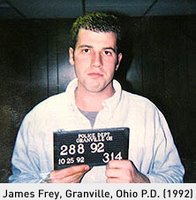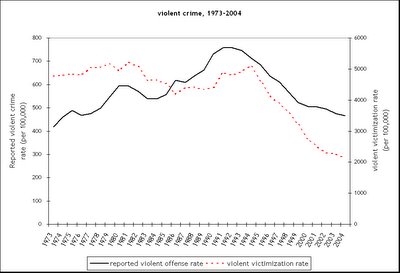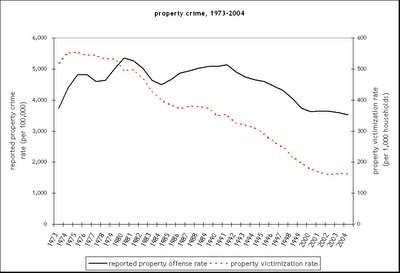 james frey is under siege for fabricating big chunks of his monster-selling memoir, a million little pieces. the minneapolis strib had questioned his accounts of surgery without anesthesia and a northwest airlines flight in which he was bleeding, with a hole in his cheek, and covered with “a colorful mixture of spit, snot, urine, vomit and blood.” as the smoking gun reports, frey represented the memoir as non-fiction but, to put it charitably, seems to have seriously exaggerated his experiences. here’s the short version:
james frey is under siege for fabricating big chunks of his monster-selling memoir, a million little pieces. the minneapolis strib had questioned his accounts of surgery without anesthesia and a northwest airlines flight in which he was bleeding, with a hole in his cheek, and covered with “a colorful mixture of spit, snot, urine, vomit and blood.” as the smoking gun reports, frey represented the memoir as non-fiction but, to put it charitably, seems to have seriously exaggerated his experiences. here’s the short version:
“When recalling criminal activities, looming prison sentences, and jailhouse rituals, Frey writes with a swaggering machismo and bravado that absolutely crackles. Which is truly impressive considering that, as TSG discovered, he made much of it up. The closest Frey has ever come to a jail cell was the few unshackled hours he once spent in a small Ohio police headquarters waiting for a buddy to post $733 cash bond.”
i think we should give folks a little wiggle-room on their memoirs, so i feel bad for mr. frey. of course, misrepresenting one’s criminal history probably seems like a pathetic way to do masculinity, at least for those over 25. still, i won’t deny the seductions of embellishing such experiences. my juvenile delinquency students know that i’ll sometimes refer to my experiences in the system. i’ve never hidden the fact that i was arrested several times at 16 and 17 (mostly for fighting and disorderly conduct) or that i had sleepovers in jails and other secure facilities. it can be useful in showing the discrepancy between the clean flow-chart picture of the system in textbooks and the messy experience of things like juvenile intake from a kid’s perspective. but whenever i feel any semblance of “swaggering machismo” in telling such stories, i know i’m starting to embellish — because it was never like that.
the first and most important reality checks are that i never did time (and certainly not hard time in a state penitentiary), that i’ve only seen prisons as a visitor or professor, and that i felt and was perceived as a nerd at the time or, more charitably, a hipster doofus or confused kid rather than a badass or tough guy. my guess is that frey has a similar history. this is important because the real badasses sniff out a phony in a second. when i interview men and women in prison, i represent myself as a dork professor rather than someone who has “been there.” even if i wanted to sell myself as an ex-con, i couldn’t pull it off. similarly, none of my publications on crime make any mention of my own history — i’m not embarrassed, it is just way too “thin” to be of any use. it certainly affects the kinds of questions i ask and the perspectives i adopt, but it would be the height of phoniness to trade on it.
also, the memory plays tricks. for example, i think i was arrested at 17 for stupidly attacking a bouncer at the cabooze, right down cedar avenue from my current office in minneapolis. if i were writing an account of the evening for my memoirs (or blog, i suppose), it would be tempting to embellish this “fight” (which was probably over in 2.4 seconds) as some sort of gladiator-style struggle and half-remember all sorts of details from all sorts of sources. just like mr. frey, i could see myself writing about being covered with “a colorful mixture of spit, snot, urine, vomit and blood.” after 24 years, though, all i can really remember is that the band was wilma and the wilburs. i think i was handcuffed for a long time that night/morning and that it hurt, but that could have been a different night altogether. if the smoking gun investigated my blogoirs, they might discover that it was bullwinkles rather than the cabooze or, worse, that i was not arrested in hennepin county that night (hmm. was it ryan’s in ramsey county?).
i’m thinking about embellishment because my son is now a wrestler and musician — two activities that i explored at 14 too. i thought i was a pretty scrappy wrestler, but had to ask my dad whether i was really any good at it (verdict: fought like hell, but lost as much as i won). i know that i was never a good guitar player (“scrappy” probably applies here as well), though i’m sometimes tempted to embellish my experiences or abilities here too. my delinquent history hasn’t really been questioned, though those who knew me at 16 love my little joke about preparing a lifetime to “teach a course in juvenile delinquency.”
so, even if mr. frey was never the badass of a million little pieces, he probably had some experiences that were something like the events described in the book. or maybe they were stories he heard in treatment. why do we embellish our deviance? hmmm. edwin lemert noted long ago (1951) that rewards as well as penalties derive from deviant roles. rw connell explains the general swagger and jack katz explicated the specific ways of the badass. now that he’s apparently been busted, the arc of frey’s story fits goffman’s (1961) sad tale, and shadd maruna‘s redemption scripts might help us figure out his next move.
prediction: his next book is gonna be huge.





